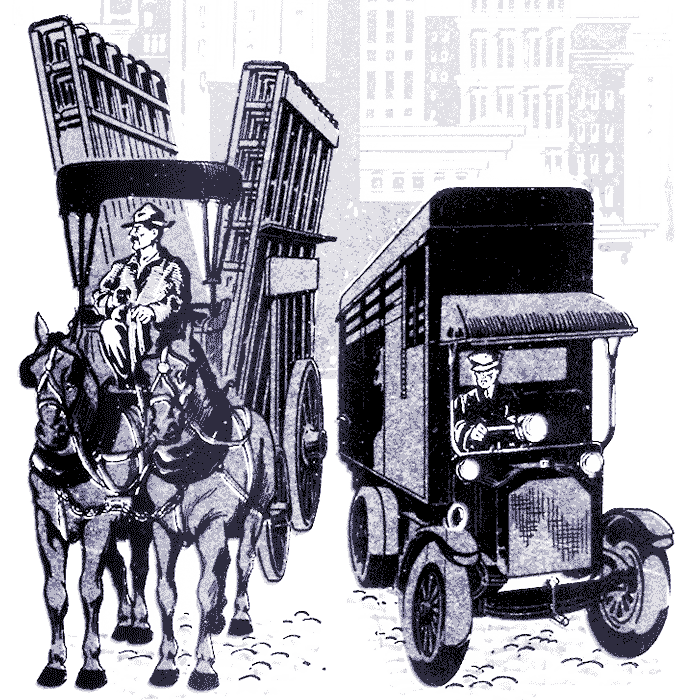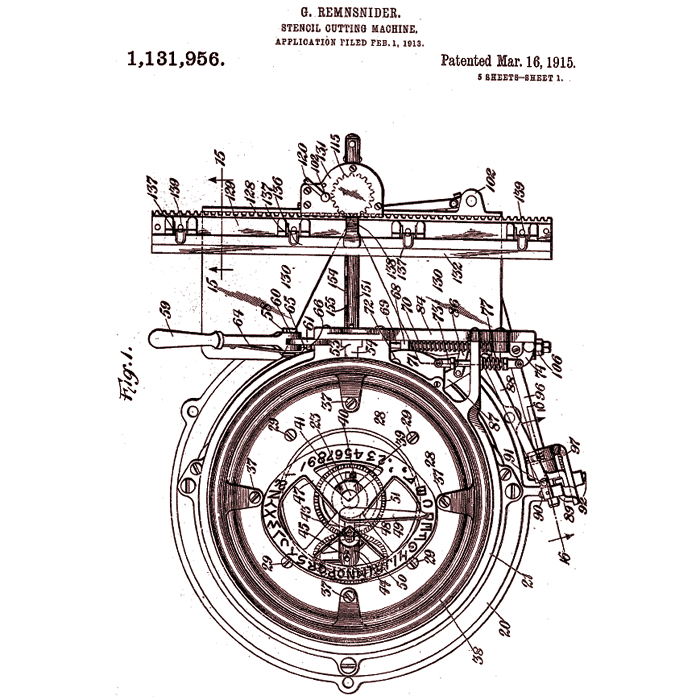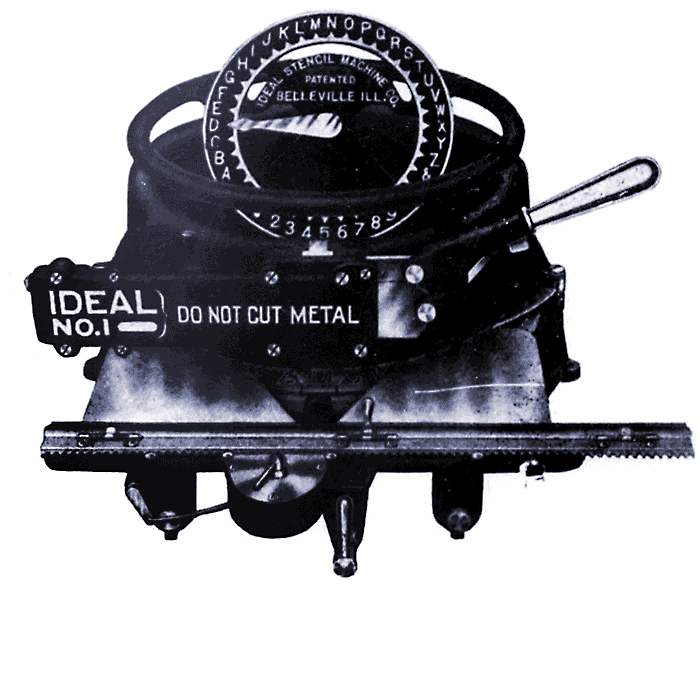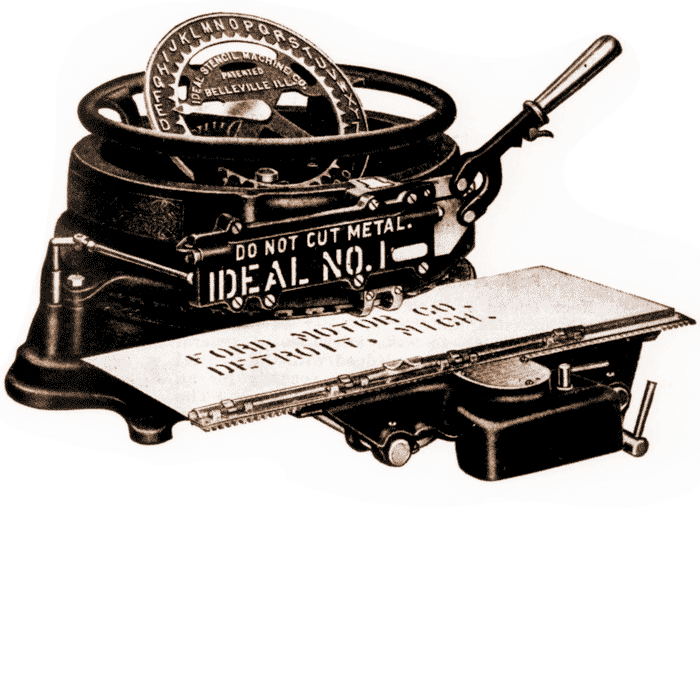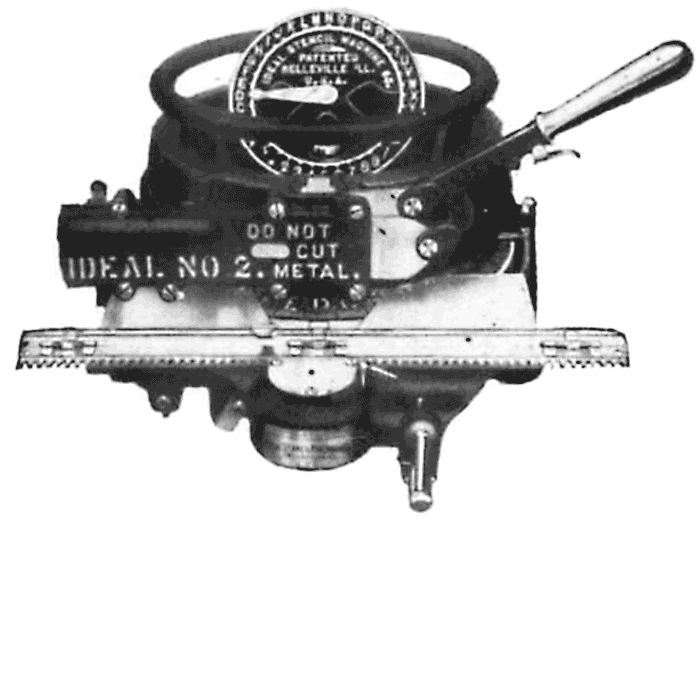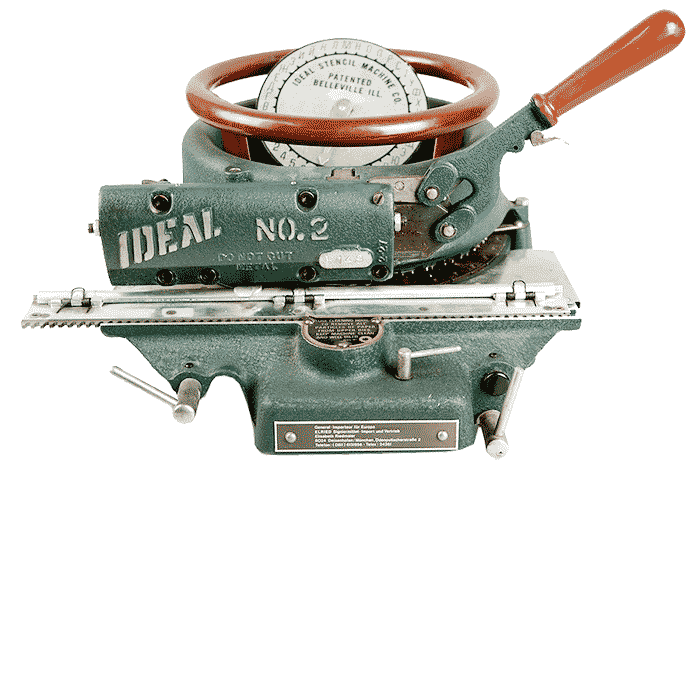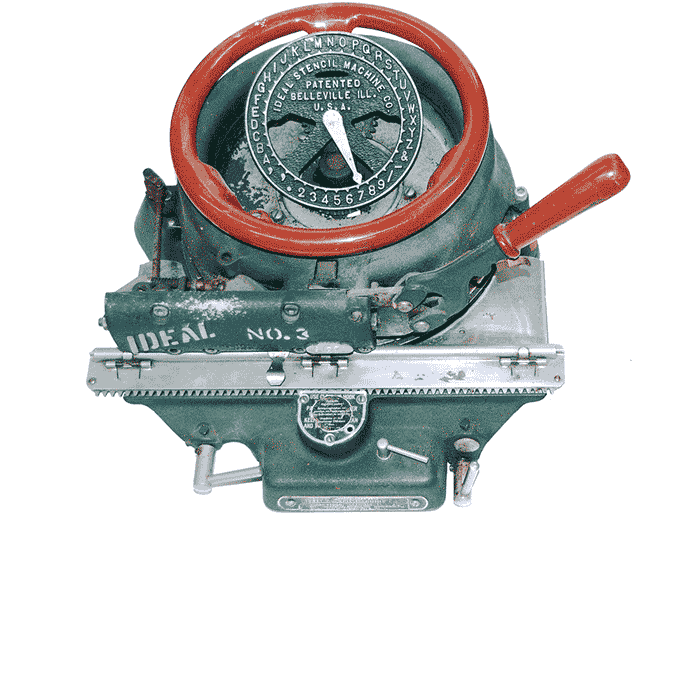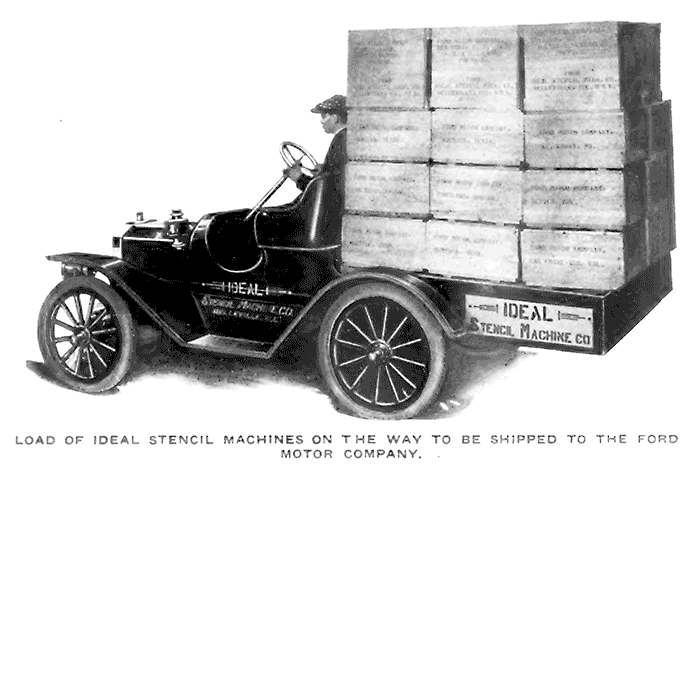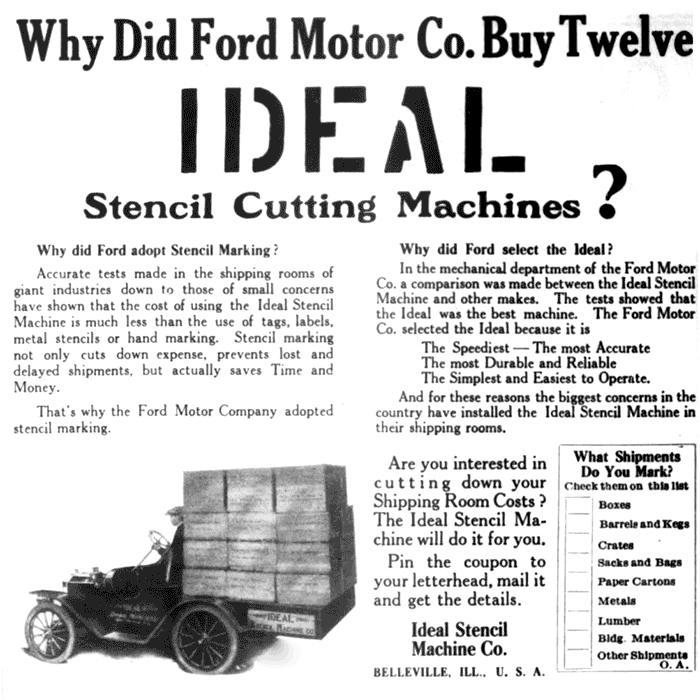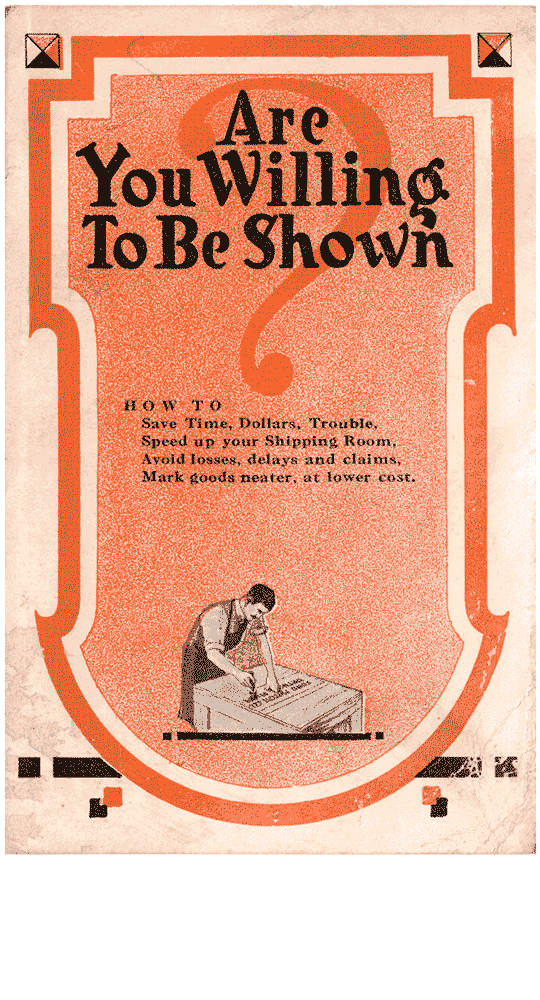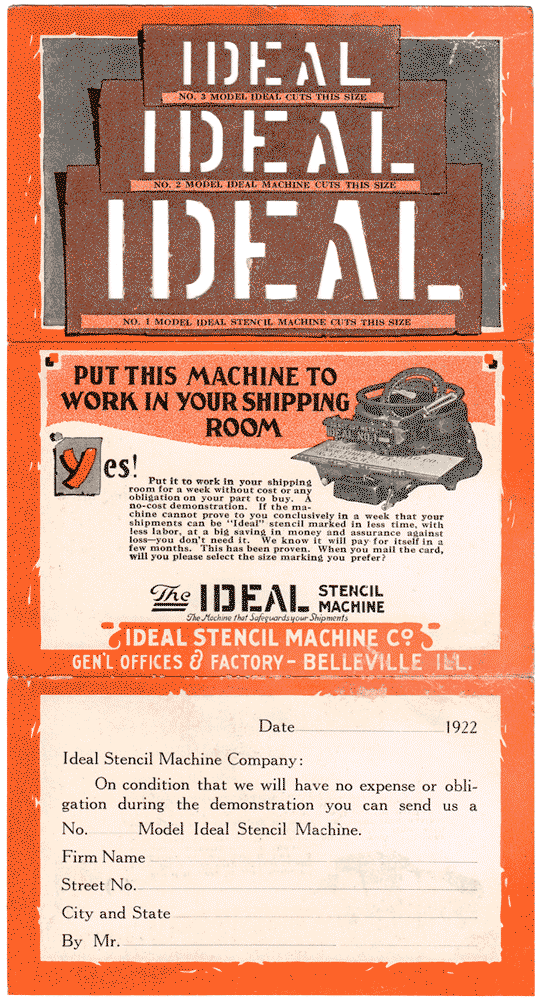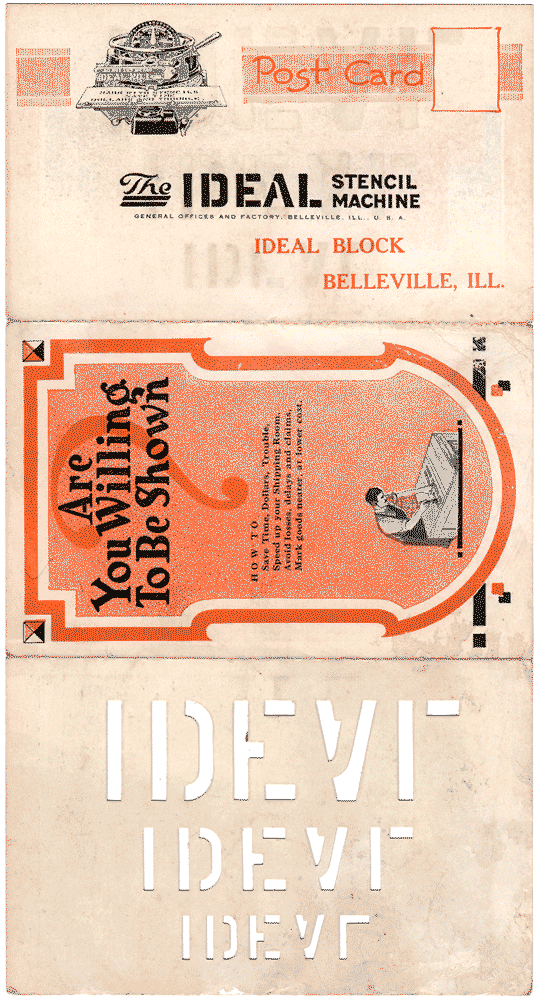Early Company History
Early History of Ideal Stencil Machine Co.
George Remnsnider,
engineer and inventor – production manager and president
In 1911, inventor George Remnsnider, who lived in the town of Belleville, Illinois, known for its iron stoves, on the border of St. Louis, Missouri, and several other businessmen formed a new company to manufacture stencil machines.
It was the third such company. It was to be called Ideal Stencil Machine Co.
The company's initial capital stock was $50.000, increased to $80.000 in 1913.
1914 — Imagine, this was the last year that horseshoes were advertised more than cars!
G. Remnsnider, note the English adaptation of the German name »Riemenschneider«, had already proven himself as a capable developer and technician.
So he improved the stencil machines for the Bradley Stencil Machine Company.
He also worked on improving the manufacturing process of punches and dies.
He even holds a patent for a street sweeper.
So it is no coincidence that G. Remnsnider came up with a new stencil cutting machine.
That, of course, had nothing to do with the old patents of the two companies already on the market.
These were Bradley Stencil Machine Company, founded in 1893, and Diagraph Stencil Machine Corporation, founded in 1902.
Both companies, and future competitors, were located just a few miles across the state line in St. Louis.
They knew each other and knew that, as in any business, when a lot of money is at stake, the stakes are high.
So his invention had to be really new and safe.
His 1911 and 1915 patents for this machine is evidence of this fact.
These patents show the construction and the characteristics of all future Ideal stencil machines.
Patent No. 997,582,
dated July 11, 1911, filled September, 1910.
Patent No. 1,131,956,
dated March 16, 1915, filled February, 1913.

Ideal No. 1, Q1 1913
The first machine - the Ideal No.1, (1 inch type size)
The novelty of the first machine, called the Ideal No.1, was the way the oil board was inserted into the machine.
That is why the machine was dubbed »the typewriter of stencil cutting«.
The oil board was clamped on a movable carriage, similar to a typewriter.
The machine had automated carriage return and line spacing could be reduced with an optional alternative carriage.
They were intended to be more economical than the Bradley and Diagraph models.
The letter spacing was tighter and the stencil type size range of the later models, was slightly different to competitor models.
The Ideal stencil machine No.1 was introduced at the National Business Show in St. Louis in early 1913.
That same year, independent salesman opened offices in New York, St. Louis, Seatlle, Milwauke, Detroit, Philadelvia, Boston, Pittsburg, Kansas City, Portland, Dayton, New Orleans and San Francisco.
The first international distribution partners were Excelsior Supply Company of Sydney, Australia, H. Barnard & Co., Hamilton, Ontario, Canada, and Deutsch-Amerikanisches Exporthaus of Berlin, Germany.
The first edition of the machine, as shown in the adjacent picture from a 1913 advertisement, had a slightly different front.
The characteristic lettering IDEAL No. 1 was placed on the left side of the body and shows common (no stencil) letters of the Ideal logo type.
»DO NO CUT METAL« was on the right side.
It was not until around 1920 that the lettering »IDEAL NO. 1« appeared in the typical stencil look - now in a single line across the front.
Frankenstein type
Technical Shapes vs. Zeitgeist
Remember the horseshoe and car analogy?
People really appreciate the ornament at that time.
All valuable things needed boundaries and flourishing.
Even the very first models of the Ideal machines had golden lines of ornamentation.
The new typeface that this machine cut was a completely unromantic — a Bauhaus-style Gothic construction.
By the standards of the day, it must have seemed like something out of Frankenstein.
But this was purely for the purpose of producing the most wear-free punches and dies in the most cost-effective way possible.
Competitor Diagraph Stencil Machine Corporation did the same 10 years earlier.
The long established Bradley Stencil Machine Company that used a Roman typeface has also adopted these simplified forms for some of its later models.
An Ideal No. 1 machine of the first series can be seen in the
Labor & Industry Museum, Belleville.
Also a copy of the company house booklet »The Ideal Salesman«.

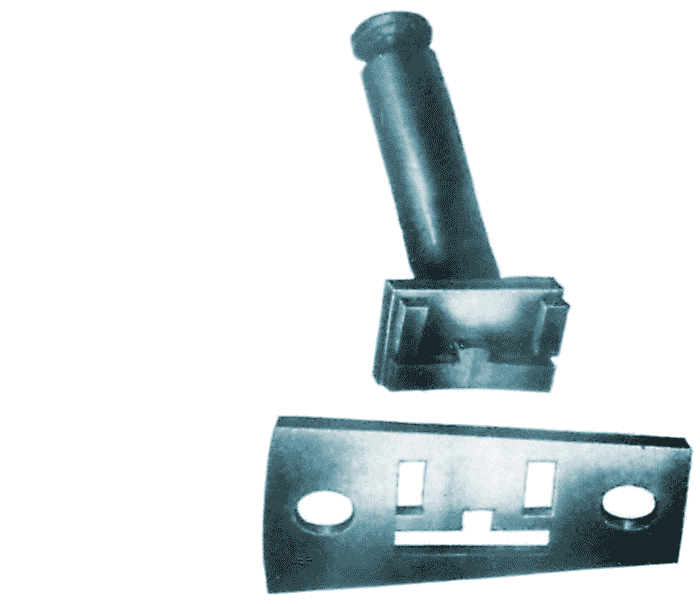
Ideal No. 2, April 1913
5/8" type size
Additional stencil machines for smaller type sizes were quickly developed to expand the product range and meet customer demands.
The second 5/8" Ideal No. 2, followed in April 1913, already featured the stencil look in the Ideal logo.
But even here, the logo looks a little different than on the later models, where the Ideal logo is slanted.
There were especially lightweight aluminum demonstration models of this machine that weighed only 30 pounds.
Salesman could easily disassemble and carry these machines.
The 1924 book American Digest of Business Machines lists the price of the Ideal No. 1 machine as $125, and the Ideal No. 2 and No. 3 as $110 each.
Ideal No. 3, 1916
7/16" type size
Marking for War - Big Business
With the introduction of the third model in 1916, the company had a model line sufficient for many fields.
The foreseeable entry of the U.S. into World War I and the resulting additional logistical effort of in the country, brought an initial surge in sales and production in 1916 and 1917.
The government purchased for the Army and Navy stencil machines from all manufacturers.
It was during these years that the Ideal company established itself and became a serious competitor to both Bradley and Diagraph.
John W. Marsh - first secretary
One of the co-investors of the Ideal company was self-made businessman John William Marsh, 42, also of Belleville.
He was a salesman and manager with many years of experience.
J. W. Marsh became treasurer and first secretary of the new company.
He later rose to the position of general manager and remained in that position until 1920.
President of the company was the inventor, G. Remnsnider.
But wait. Marsh - you guessed it. The same J. W. Marsh would go on to found the fourth company in this field of industry, Marsh Stencil Machine Company.
But that's another story.
However, this point is important to understand how Ideal company managed to sell in the first 10 years.
It was not enough to have a good product. The world and the customers had to be convinced.
Ideal's corporate communications and public relations were in the hands of J. W. Marsh.
Ideal's success is also due to him.
Ideal Co.'s marketing relied on four pillars: trade magazine advertising, direct mail, independent sales representatives, and trade shows.
However, magazine advertising was used very selectively. Not every year had as much advertising as 1913.
However, when Ideal had a large order, such as the sale of 12 machines to the well-known Ford Motor Company in 1914, they issued press releases and advertisements that sometimes brought in free mentions.
The direct sales approach was to write to large companies that were thought to maintain a large logistics department.
The Ideal machine was advertised as saving 20% or 25% of oil board, or that the cutting process was more accurate (better straight lines of text) and faster than competing machines.
The customer was offered a machine to try out for 10 days.
There was also a promotion that customers could order a free copy of Ideal's publication, »Protect Your Shipments.«
The direct mailings were well done in terms of advertising and, by the standards of the time, lavishly produced.
The machine stencils were punched into the flyer so the customer had an accurate idea of the type size of each of the three Ideal machines.
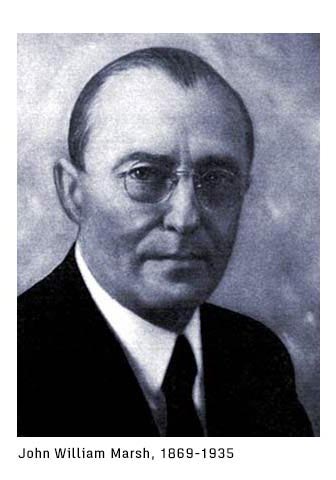
Sales & Marketing
Building a Network of Sales Offices
Another form of distribution was through independent salesmen who sold Ideal machines in their respective states and regions of the USA and trade shows.
These salesmen also sold other products.
Because the fledgling Ideal company did not offer a broad range of self-developed supplies such as ink, ink-applicators, and the all-important oil board, these merchants also worked with suppliers.
One of these suppliers was Garvey (Garvey Fountain Brush and Ink Co., St. Louis, Missouri), known for the Garvey Fountain Brush and in business since about 1900.
But Garvey also cooperates with competitors like Diagraph.
It is said to have been this »grievance« that caused J.W. Marsh to think about starting a company of his own.
At least that is what the official chronicle of the Marsh company, published on the occasion of the company's 75th anniversary in 1996, says.
The Ideal Fountain Brush, which has been advertised by Ideal, was a product of the Universal Fountain Brush Company of Florida.
In the early years, the Ideal company invited these important merchants to an annual meeting with a festive banquet and a series of lectures.
J. W. Marsh presided at these events.
The 1917 meeting even received a full page in the April 1917 issue of the trade journal Office Appliances, and the accompanying photo (Elks Club, Belleville) is from that article.
John W. Marsh, leaving - 1920
With the leaving of J. M. Marsh in 1920, which caused quite a stir in the local press, the Ideal company became somewhat quieter in terms of publications.
The new Marsh company was all the louder for it.
Ideal was well established in the market due to its good machines and J. W. Marsh's tight sales management.
To read a full article about John W. Marsh's new company, visit the astype fonts Marsh website.
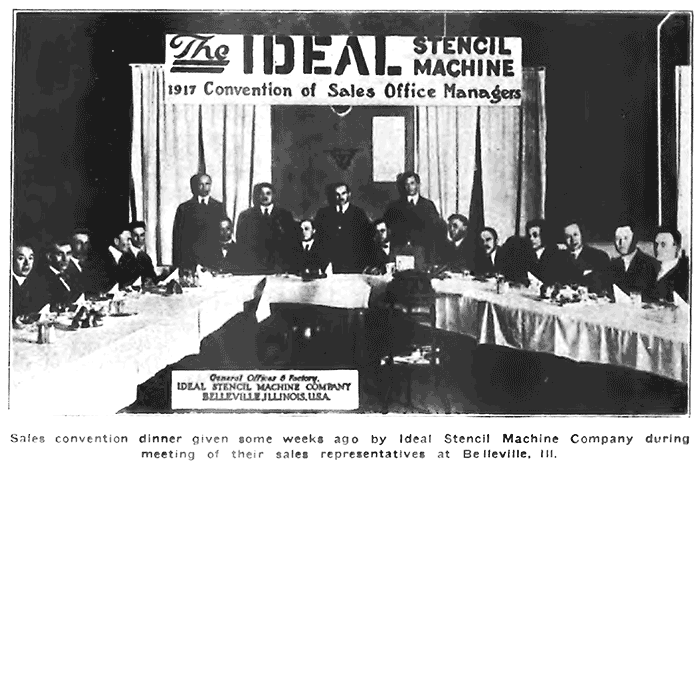
104 Iwoa Avenue,
Belleville, IL
The 1951 book "A History of Belleville" briefly mentions the Ideal and the Marsh company.
The book refers to articles from the late 1930s.
Unfortunately, it is not clear what year the company information about Ideal refers to.
So it is written about the Ideal company, quote:
Two of the only four stencil machine factories in the world are located in Belleville.
The others are in St. Louis.
The Ideal Stencil Machine Company, perhaps the best equipped, receives its castings from the Excelsior Foundry located in the same block.
Its annual production is about $150,000, and it employs 24 people.
No company address is given either.
In early Ideal adverts, it only says »Belleville, 14 miles east of St. Louis«.
As of 1916, »20 Ideal Block« is specified.
As of 1918, »31 Ideal Block«, and as of 1920, »151 Ideal Block«.
It was not until about the 1930s that the address "104 Iowa Ave." appeared, which remained the same until the end of the company.
to be continued ...
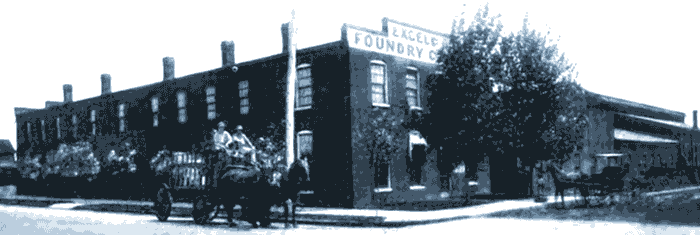
Excelsior Foundry, 1200 East B Street, Belleville
1956 - Ideal Quarter and Air Power
After 43 years, a new model of an Ideal machine was introduced, the Ideal Quarter, which cut 1/4 inch stencil type.
Probably in the same year, the Ideal Eight with 1/8" type height appeared.
Also introduced that year was the «Air Power» unit.
The stencil machines modified with this unit could cut the stencils at the push of a button using compressed air.
to be continued ...
1978 - part of the Italian VIBAC group
In 1978, the ownership of the company changed. It became part of the VIBAC Group, an Italian company based in Ticineto and a leading manufacturer of pressure sensitive packaging tapes.
The acquisition of Ideal Co. was probably of interest to VIBAC because it provided a cost-effective entry into the US market for its packaging tapes.
The president of Ideal Co. at that time was Alberto Merchiori.
to be continued ...
1981 - company name change
The trade journal Adhesives Age announced in the issue 12 of 1981, that the Ideal Stencil Machine Co., Bellville, Ill., has changed
its name to Ideal Stencil Machine and Tape Co. to emphasize the firm's line of shipping room tape products.
to be continued ...
2002 - End of the Ideal Co.
After more than 90 years, Ideal Company ended in June 2002 when it was purchased by Illinois Tool Works (ITW).
ITW also owns Diagraph Company and planned to merge the remnants of Ideal with Diagraph.
It is not entirely clear what was purchased.
It would probably be pure speculation to suggest that this was a market-clearing event.
ITW and Diagraph do not support old Ideal machines, nor do they use the Ideal brand.
The former factory building is used by the new company U-Mark, founded in 2002 by the last manager of Ideal Co., Marco Ziniti.
U-Mark manufactures ink products for all types of marking applications and also sells stenciling equipment such as Marsh manual stenciling machines.
Ideal Stencil Machine Co. and Marsh Stencil Machine Company were among the businesses that shaped Belleville and its people for nearly a century and left their mark on the world.
Considering that the two former factory buildings are just over 5 minutes apart, there will be many stories worth telling.
Sources
- Google Patent Search
- Trade Journals: Office Appliances, Traffic World, Adhesives Age ...
- Book, Making their Mark in the World, The history of the Marsh Company, Belleville, IL, published by Marsh Co., 1996
- Book, A history of Belleville by Nebelsick, Alvin Louis, published by Township High School and Junior College, Belleville, Il, 1951

